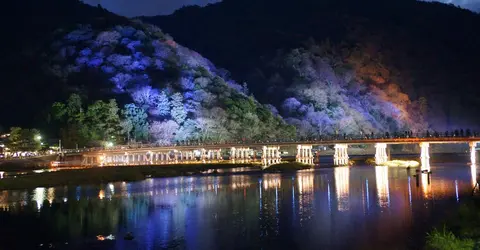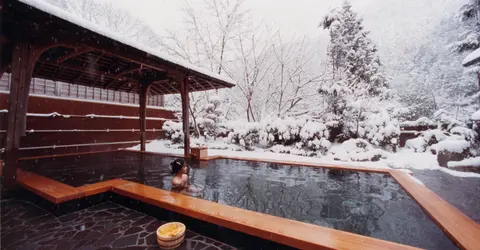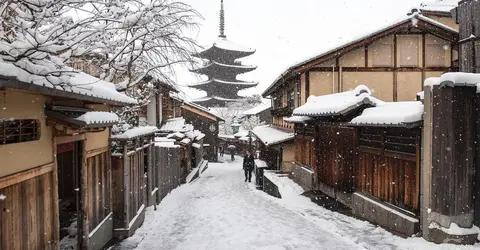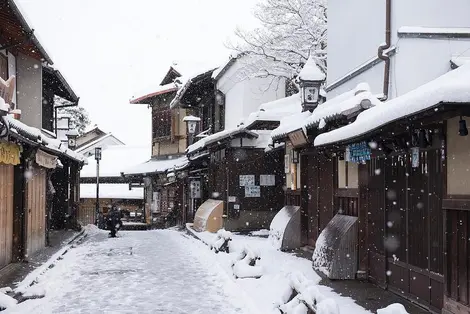5 ways to enjoy Kyoto in winter
5 ways to enjoy Kyoto in winter
Winter can be a great season to visit Japan. Generally visited during the spring or fall, Kyoto is also delightful in winter. Here are 5 ways to enjoy a more peaceful and enchanting Kyoto during the winter months!
Admire the temples under a layer of snow
Enjoying the splendid snow-covered Buddhist temples and Shinto shrines in the city is magical experience. The majestic temples and pagodas look even more beautiful covered in snow, adding to their sense of calm. The gardens are just as stunning when dusted with snow and demonstrate that Japanese gardens can be enjoyed throughout the year.
Kinkaku-ji (the Golden Pavilion) is particularly impressive during the winter when the snowfalls.
To discover: The temples and shrines of Kyoto

Kinkakuji in winter
Wikimedia Commons
Take part in festivals
Kyoto is home to many festivals during the winter. The most famous are Toshiya, which is held around January 15th, and Setsubun, February 3rd. Toshiya is an archery competition practiced by young women dressed in kimonos when they officially become adults at the age of 20. This ceremony, which takes place every year at City Hall, is an important rite for the people of the city and is also very beautiful to observe.
Setsubun celebrates the end of winter. In Kyoto, it takes place at Yasaka Shrine in Gion where maiko and geisha throw of dried beans into the crowd, with the aim of chasing away evil spirits.
For further reading: Festivals and events in Kyoto
Enjoy an onsen
With the cool temperatures of the winter months and the sometimes icy cold in Japan, it's great to warm up. Kyoto is home to many hot springs (onsen), where you can immerse yourself and relax. This can be a good time to try a ryokan (traditional inn), which often offer onsen to its guests.
In the city center, you'll find many onsen with indoor pools. But it's in Kurama, a small village easily accessible to the north of the city, that you will find Kurama Onsen, which offers the opportunity to bask in the hot water outdoors. You'll enjoy a view of the surrounding mountains, during a moment of relaxation, in sulfuric water with curative properties...

Hanatouro festival, Kyoto
Flickr, Orange Tuma
Contemplate the plum blossoms (Ume Matsuri)
At the end of February, before the well known cherry blossoms (hanami), it's the plum trees that bloom. You can admire the delicate flowers, whose color varies from white to deep pink, throughout Kyoto.
The blossoms are particularly spectacular at Kitano Tenmangu Temple, home to nearly 2,000 plum trees. In addition, every year, the temple hosts the Baika-sai festival, which includes an outdoor tea ceremony, led by geiko and maiko.
At Kaju-ji, you can admire a very old plum tree and its bright pink flowers, directly transplanted from the Imperial Palace.
To read: Plum Blossom Festivals
See Hanatouro, the festival of lights
Head to Arashiyama, west of the city, to enjoy a splendid winter event: Hanatouro, the festival of lights. During a trip along Togetsukyo Bridge over the Katsura River, nearly 2,500 white or colored lanterns are strung up for a magical atmosphere. The bamboo forest of Arashiyama, which is also illuminated, also offers a most enchanting stroll.

Kurama Onsen pond in winter
DR
A similar event takes place in March in Higashiyama, east of the city, in traditional Kyoto neighborhoods.

Kyoto in the snow
Patrick Vierthaler
Pratiquer des activités de plein air hivernales
Bien que Kyoto ne soit pas une destination de sports d'hiver à proprement parler, la région offre néanmoins quelques possibilités pour profiter des joies de la neige. La station de ski de Biwako Valley, située à environ une heure de Kyoto, propose des pistes adaptées aux débutants comme aux skieurs confirmés. Depuis les pistes, vous pourrez admirer la vue imprenable sur le lac Biwa, le plus grand lac d'eau douce du Japon.
Pour une expérience plus contemplative, optez pour une randonnée hivernale dans les montagnes entourant Kyoto. Le mont Hiei, accessible en téléphérique, offre des sentiers balisés et des vues panoramiques sur la ville. En hiver, la montagne se couvre de neige, créant des paysages d'une beauté féerique.
Enfin, ne manquez pas l'opportunité de participer à un bain de forêt hivernal, ou shinrin-yoku. Cette pratique japonaise consiste à s'immerger dans l'atmosphère de la forêt pour ses bienfaits sur la santé. En hiver, le silence de la forêt enneigée et l'air pur vous procureront une sensation de calme et de ressourcement incomparable.















